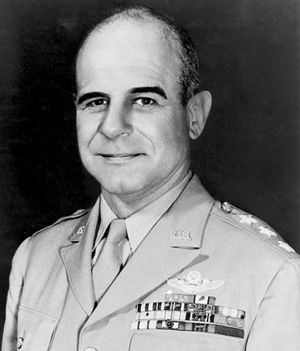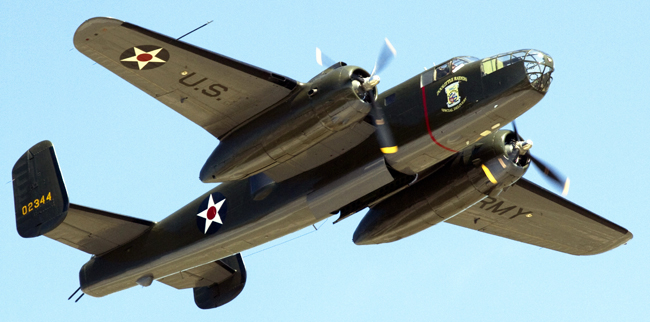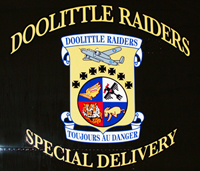Doolittle's Raid
Today, a costly gesture that may've saved America. The University of Houston's College of Engineering presents this series about the machines that make our civilization run and about the people whose ingenuity created them.
If you're hearing this episode in a rerun, remember the date it first aired -- April 18, 2012. That's the 70th Anniversary of Jimmy Doolittle's WW-II bombing raid over Tokyo. Sixteen B-25 medium bombers flew the mission. Their bombs did little direct damage. We lost all 16 planes and eleven out of eighty airmen.
That does not sound like much of a history book entry, does it? But look at it from my 11-year-old perspective: Four months earlier, Japan had severely damaged our Pacific fleet at Pearl Harbor. Then they'd taken Wake Island, the Philippines, and much of Southeast Asia. Japan seemed unstoppable and Germany had gained control of most of Europe. We were caught in a war we might well lose. And the consequences of losing would be unthinkable.
 Then, back home, we got the news -- we'd done the impossible. Tokyo was thousands of miles from our nearest base, yet we'd bombed it. Where had our airplanes come from? The answer, we were told, was the mythical city of Shang-ri-la. No matter, the raid revealed that America might not be lost after all.
Then, back home, we got the news -- we'd done the impossible. Tokyo was thousands of miles from our nearest base, yet we'd bombed it. Where had our airplanes come from? The answer, we were told, was the mythical city of Shang-ri-la. No matter, the raid revealed that America might not be lost after all.
It'd been President Roosevelt's idea. He saw the value of touching the Japanese homeland as soon as possible. A naval officer suggested that twin-engined bombers could launch from an aircraft carrier. Was that possible? The person chosen to design such an operation was Jimmy Doolittle, a 45-year-old aerial pioneer, then a lieutenant colonel in the Army Air Corps.
Now problems arose: One might find a bomber that could take off from an aircraft carrier; but landing on one was out of the question. They could probably launch within 600 miles of Japan, but they'd have to continue a 2500-mile flight all the way to unoccupied China. Doolittle decided to use modified B-25s. One crew member and most of their guns had to be removed. The bomb load was reduced. But that doubled the plane's fuel capacity and its range.

Doolittle Raider B-25 replica flying in the Wings over Houston Air Show
 So most of the planes made it to crash landing sites in China, where three men died. One plane landed in Vladivostok where the Russians claimed it. And they interned its crew. The Japanese captured eight crewmen, executed three, and one died in captivity. But 69 men eventually found their way back to the United States.
So most of the planes made it to crash landing sites in China, where three men died. One plane landed in Vladivostok where the Russians claimed it. And they interned its crew. The Japanese captured eight crewmen, executed three, and one died in captivity. But 69 men eventually found their way back to the United States.
And Roosevelt was proved right. The seemingly foolhardy attack buoyed the Allies. And Japan decided it now needed a defensive perimeter. A month and a half after the raid, Japan tried to capture our Midway Island airbase. There, the Americans ambushed their fleet and dealt it a blow from which it never recovered.
So April 18th really is a day to remember. At first glance it seems little more than the old idea of counting coup -- striking a blow that would gain only prestige. But that secret flight from Shang-ri-la -- from the Hornet aircraft carrier -- changed everything just when our very survival seemed in doubt.
I'm John Lienhard at the University of Houston, where we're interested in the way inventive minds work.
See the Wikipedia Articles on Jimmy Doolittle, the Doolittle Raid, and the Battle of Midway. See also the Doolittle Tokyo Raiders home page. For glimpses of Doolittle's work in civilian flight see Engines Episodes 1852 and 2233. Not mentioned in my text is the fact that the Japanese also tried to claim Guadalcanal for a defensive airbase and were again defeated, but in a nasty year-long battle. My thanks to Col. John Culclasure (Ret) for pointing out the anniversary and for other insights. The Doolittle photo is courtesy of Wikimedia Commons. The other photos are by J. Lienhard

This episode was first aired on April 18, 2012